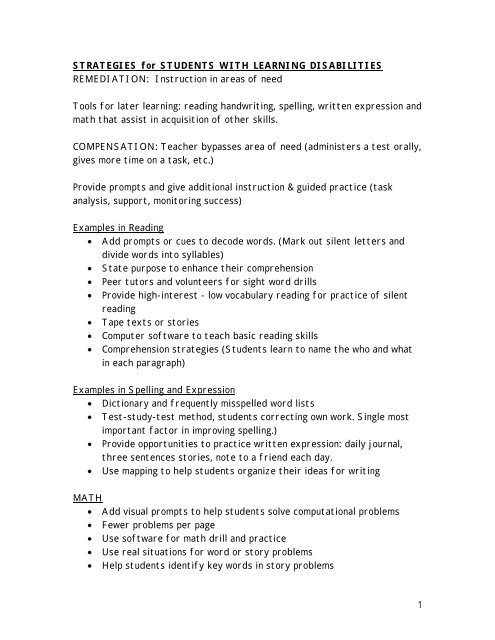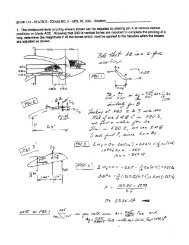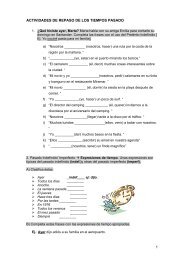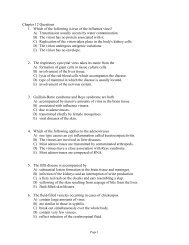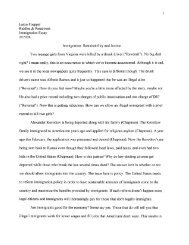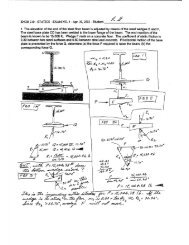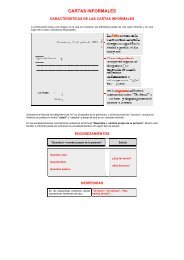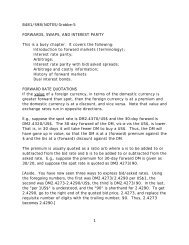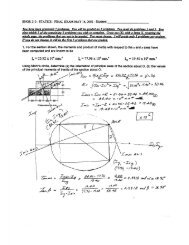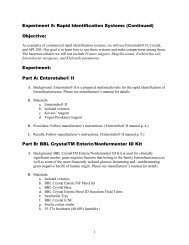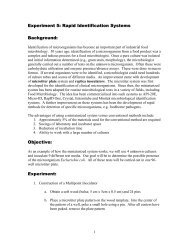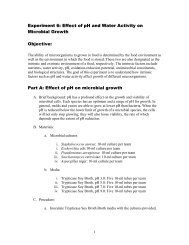STRATEGIES for STUDENTS WITH LEARNING DISABILITIES
STRATEGIES for STUDENTS WITH LEARNING DISABILITIES
STRATEGIES for STUDENTS WITH LEARNING DISABILITIES
You also want an ePaper? Increase the reach of your titles
YUMPU automatically turns print PDFs into web optimized ePapers that Google loves.
<strong>STRATEGIES</strong> <strong>for</strong> <strong>STUDENTS</strong> <strong>WITH</strong> <strong>LEARNING</strong> <strong>DISABILITIES</strong><br />
REMEDIATION: Instruction in areas of need<br />
Tools <strong>for</strong> later learning: reading handwriting, spelling, written expression and<br />
math that assist in acquisition of other skills.<br />
COMPENSATION: Teacher bypasses area of need (administers a test orally,<br />
gives more time on a task, etc.)<br />
Provide prompts and give additional instruction & guided practice (task<br />
analysis, support, monitoring success)<br />
Examples in Reading<br />
• Add prompts or cues to decode words. (Mark out silent letters and<br />
divide words into syllables)<br />
• State purpose to enhance their comprehension<br />
• Peer tutors and volunteers <strong>for</strong> sight word drills<br />
• Provide high-interest - low vocabulary reading <strong>for</strong> practice of silent<br />
reading<br />
• Tape texts or stories<br />
• Computer software to teach basic reading skills<br />
• Comprehension strategies (Students learn to name the who and what<br />
in each paragraph)<br />
Examples in Spelling and Expression<br />
• Dictionary and frequently misspelled word lists<br />
• Test-study-test method, students correcting own work. Single most<br />
important factor in improving spelling.)<br />
• Provide opportunities to practice written expression: daily journal,<br />
three sentences stories, note to a friend each day.<br />
• Use mapping to help students organize their ideas <strong>for</strong> writing<br />
MATH<br />
• Add visual prompts to help students solve computational problems<br />
• Fewer problems per page<br />
• Use software <strong>for</strong> math drill and practice<br />
• Use real situations <strong>for</strong> word or story problems<br />
• Help students identify key words in story problems<br />
1
• A class store, bank or stock exchange <strong>for</strong> practice in math reasoning<br />
MODIFICATIONS FOR ADA OR ADHD <strong>STUDENTS</strong><br />
Ysseldyke, Algozzine, and Thurlow (1992) suggest:<br />
• Maintain eye contact student<br />
• Make lists to help student organize tasks<br />
• Insure student has recorded homework assignment be<strong>for</strong>e the end of<br />
the day<br />
• Alternate sitting/standing activities, allow <strong>for</strong> movement<br />
• Opportunities to demonstrate strengths at school<br />
• Help student get started with seatwork. They begin by verbalizing the<br />
steps to you.<br />
• Give extra time without criticism or fanfare<br />
• Use oral tests to assess student's mastery<br />
• Give regular feedback and praise success<br />
2


